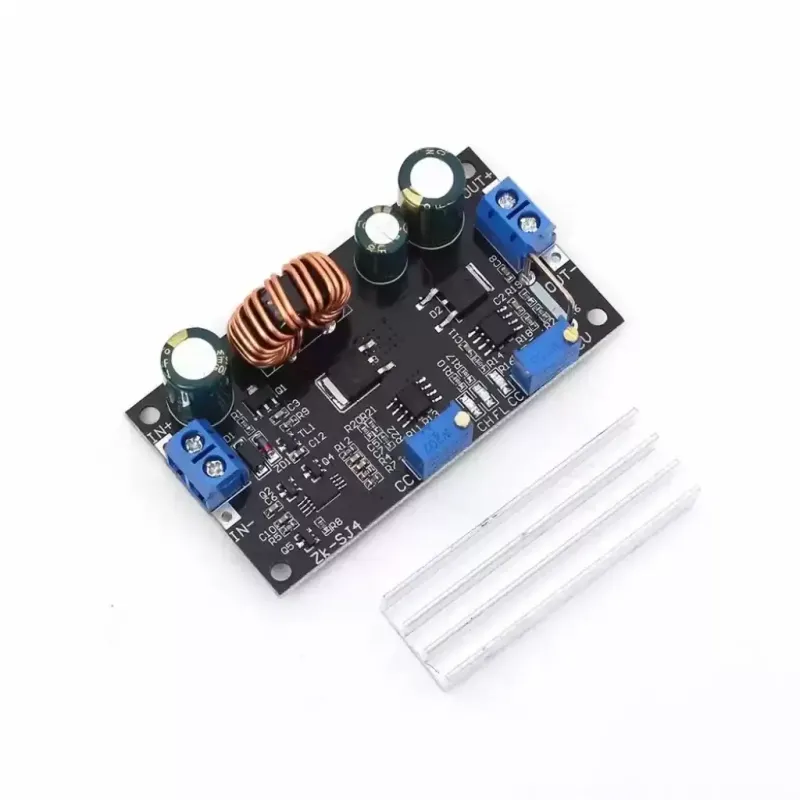
- Stock: In Stock
- Model: N021.4ASOLAR
DC-DC Step Down 4.8 - 30V 4A Automatic Solar Energy Charging Board
This top-tier module is specifically designed for solar energy applications. It boasts an automatic circuit output that charges the battery or powers devices as needed, based on the set output voltage and current. No additional connections or adjustments are necessary.With a broad input voltage range of 4.8-30V and an output voltage range of 0.5-30V, this module serves as both a boost and buck converter. For instance, if the output voltage is set to 18V, the input voltage can fluctuate between 5-30V, while maintaining a steady output of 18V. If the input is 12V, the potentiometer can be adjusted to set any output between 0.5-30V.This module surpasses the XL6009/LM2577 solutions in terms of power, efficiency, and performance. It is equipped with a large external high-voltage MOS, a large package high current, and a high voltage Schottky diode. It also features enhanced heat dissipation and a copper design.
Product Parameters
- Input voltage: 4.8-30V
- Output voltage: 0.5-30V
- Output current: Stable at 3A for long-term use, can reach 4A with enhanced heat dissipation
- Output power: 35W with natural cooling, 60W with enhanced heat dissipation
- Conversion efficiency: Approximately 88%
- Short circuit protection: Yes
- Operating frequency: 180KHz
- Dimensions: 68mm x 37mm x 22mm
- Weight: 39g
Module Usage:
As a general step-up and step-down module with overcurrent protection:
- Adjust the CV constant voltage potentiometer to reach the desired output voltage.
- Use a multimeter to measure the 10A current output short-circuit current (connect the output directly to the two test leads), adjust the CC constant current potentiometer to reach the predetermined overcurrent protection value.
As a battery charger:
- Determine the battery's charging voltage and current. For a 3.7V/2200mAh lithium battery, the float voltage is 4.2V, and the maximum charging current is 2200mA.
- In no-load conditions, measure the output voltage with a multimeter and adjust the constant voltage potentiometer to reach the float voltage.
- Use a multimeter to measure the 10A current output short-circuit current, adjust the constant current potentiometer to reach the predetermined charging current value.
- The charging light indicates when the charging current drops to 0.1 times the set value (e.g., 1A current, the light turns off when the current drops below 0.1A, indicating the battery is fully charged).
- Connect the battery to start charging.
As a high-power LED constant current driver module:
- Determine the operating current and maximum operating voltage of the LED.
- In no-load conditions, measure the output voltage with a multimeter and adjust the constant voltage potentiometer to reach the LED's maximum operating voltage.
- Use a multimeter to measure the 10A current output short-circuit current, adjust the constant current potentiometer to reach the predetermined LED operating current value.
- Connect the LED to start operation.
Precautions:
- Ensure the power supply's power time is greater than the power required by the output load.
- The module does not have input anti-reverse protection, pay attention to the positive and negative input direction.
- The input voltage should be 8V or more for maximum power output. For a 5V input, the output power is about 15W. The maximum module current is 4A, and the output should be limited to 17V and 2A.
- The module has short-circuit protection and low voltage protection features (default at approximately 4.2V, below which the output will automatically cut off and restart when the input voltage recovers).
- The module has three indicators: constant voltage constant current status indicator (red), charging indicator (blue), and full charge indicator (green, light turns on when charging current is less than 0.1 times the set value).














